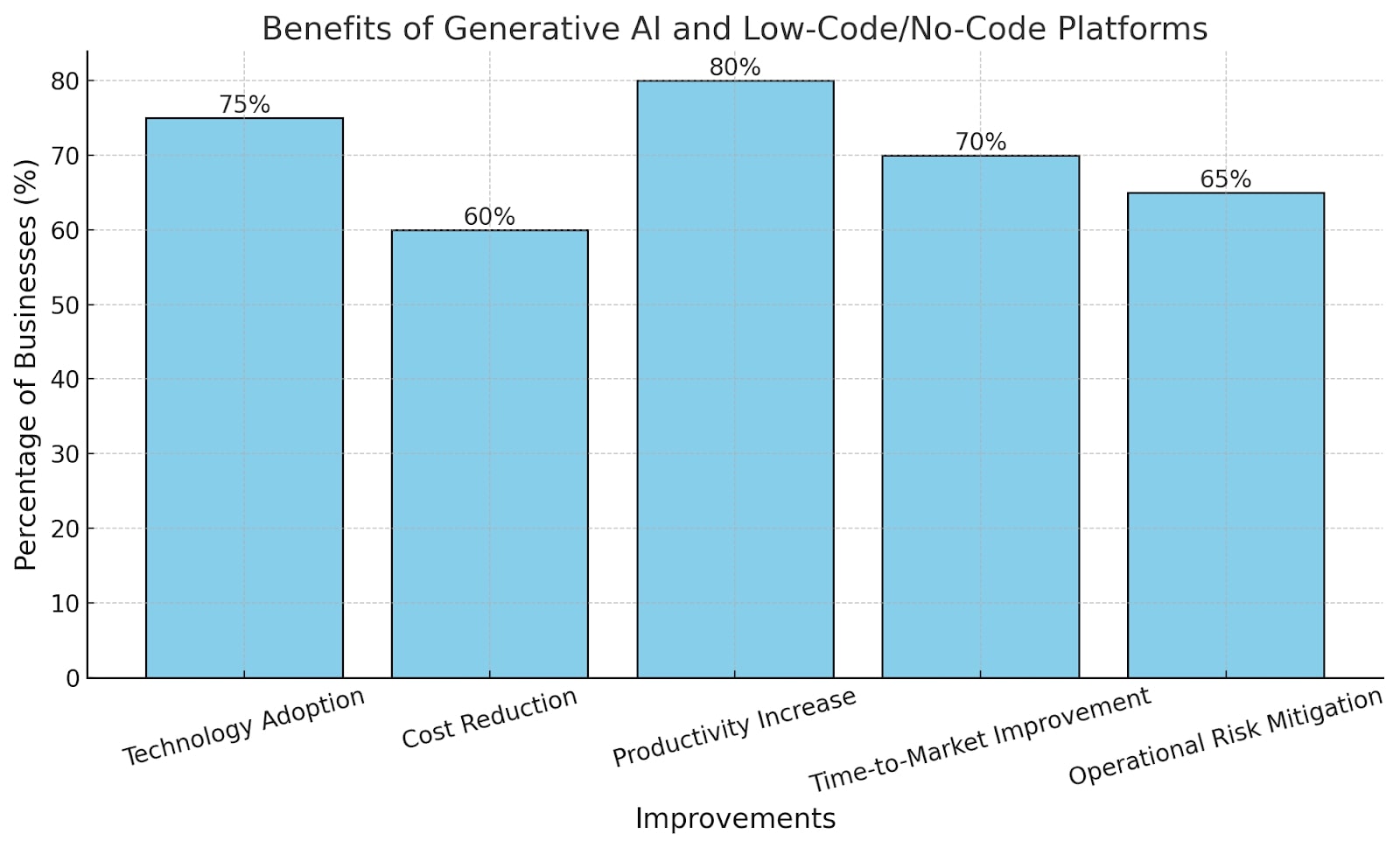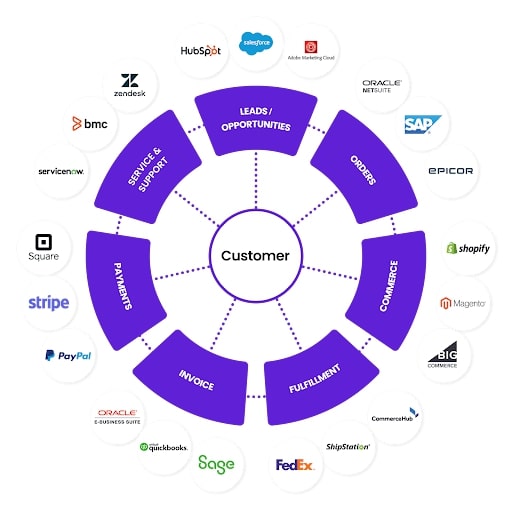Boosting Efficiency and Reducing Costs through Streamlined SAP and Adobe
Increase operational efficiency while employing cost reduction strategies.

Introduction
In today's rapidly evolving business landscape, organizations are seeking innovative strategies to enhance operational efficiency and reduce costs. A pivotal approach lies in the integration of workflows between SAP and Adobe Commerce, as these platforms together offer robust solutions for streamlining processes across various business functions.
By leveraging the interconnectedness of these systems, businesses can more effectively manage customer relationships, orders, and fulfillment, ultimately leading to improved service delivery.
The visual representation encapsulates this integration, illustrating how diverse operational categories—ranging from customer management to invoicing—interconnect to foster a holistic view of business operations.
This cohesive framework not only enhances customer engagement but also aligns various departments towards common goals, thus underpinning the argument that streamlined workflows can significantly boost efficiency while minimizing costs in a competitive marketplace.
Overview of SAP and Adobe Commerce integration and its significance in modern business operations
In today’s rapidly evolving marketplace, the integration of systems is essential for fostering operational efficiency and enhancing customer satisfaction. The synergy between SAP and Adobe Commerce exemplifies how businesses can streamline workflows, significantly reducing costs associated with business processes.
By effectively merging SAP’s robust enterprise resource planning capabilities with Adobe’s powerful e-commerce solutions, organizations are able to create a seamless flow of information across various departments, such as sales, inventory management, and customer service. This integration not only allows for real-time data access, promoting informed decision-making but also optimizes performance by addressing both the soft and hard aspects of business processes as detailed in (Evaluation and development models for business processes).
Furthermore, the development of a Temporal Meta-Model Framework highlighted in (Temporal meta-model framework for Enterprise Information Systems (EIS) development) indicates that such integrations can facilitate the automation of enterprise systems, ultimately leading to quicker deployment and maintenance. The interconnected relationships articulated further emphasize the significance of this integration in enhancing customer engagement and business agility.
Enhancing Operational Efficiency
The integration of advanced technologies within business operations fundamentally alters the landscape of operational efficiency. Notably, the implementation of Generative Artificial Intelligence (GenAI) tools facilitates significant transformations in content creation and workflow processes, resulting in cost reductions and enhanced productivity.
Businesses leveraging these technologies can automate routine tasks, thereby reallocating human resources towards more strategic functions. Furthermore, the rise of low-code and no-code (LCNC) platforms empowers organizations to streamline operations without the heavy dependencies on IT expertise, thus accelerating time-to-market for new initiatives.
This democratization of technology enables companies of varying sizes to optimize their workflows effectively, cultivating a competitive edge while simultaneously mitigating operational risks. Ultimately, the convergence of GenAI and LCNC illustrates a pivotal shift towards heightened efficiency, underscoring the importance of adopting innovative solutions in pursuit of streamlined SAP and Adobe Commerce workflows.

The bar chart displays the benefits realized by businesses that have adopted Generative AI and low-code/no-code platforms. The data highlights improvements in various operational aspects, including technology adoption, cost reduction, productivity increase, time-to-market improvement, and operational risk mitigation. The percentage values indicate the proportion of businesses reporting enhancements in these areas following the implementation of these technologies.
Analysis of workflow automation in SAP and Adobe Commerce and its impact on productivity
As organizations increasingly strive for operational efficiency, the role of workflow automation within SAP and Adobe Commerce has emerged as a pivotal factor in enhancing productivity. This automation streamlines various processes, from customer management to order fulfillment, thereby allowing businesses to allocate resources more effectively and reduce unnecessary operational costs. By seamlessly integrating disparate business functions, these platforms facilitate a unified approach that is essential for optimal performance.
The interconnectedness depicted in highlights how automated workflows can enhance customer engagement through improved management of leads, orders, and invoices. Moreover, the insights from (The “Good Enough” Tsunami : The Disruptive Potential of Low-code and No-code ) indicate that low-code and no-code technologies further democratize automation, enabling even smaller firms to compete effectively by accelerating time-to-market with minimal reliance on extensive IT knowledge. Ultimately, such advancements in workflow automation not only bolster productivity but also cultivate a more agile and responsive business environment.
Cost Reduction Strategies
In the pursuit of operational efficiency, organizations increasingly turn to integrated software solutions that streamline workflows and reduce costs. A critical analysis of the interplay between systems like SAP and Adobe Commerce reveals a path to significant financial savings by consolidating business functions such as order management, invoicing, and customer support.
For instance, the visual representation underscores how these platforms interconnect various operational categories, ultimately enhancing customer engagement while minimizing redundancy. Through effective integration, businesses can effectively utilize data across departments, thereby lowering overhead costs and improving service delivery.
Furthermore, this consolidation allows for real-time analytics, fostering quicker decision-making and resource allocation. Ultimately, embracing such holistic frameworks not only optimizes existing processes but aligns with broader strategic considerations, as discussed in insights from (An internal analysis of salesforce and the motives leading to the possible acquisition of slack) and (Industry characteristics and macro-environment aspects influencing the possible acquisition of slack by salesforce), suggesting a more adaptable and resilient organizational structure in the face of evolving market demands.
| Strategy | Estimated Cost Reduction (%) | Source |
|---|---|---|
| Automated Workflow Processes | 30 | Gartner, 2023 |
| Optimizing Inventory Management | 25 | Forrester Research, 2023 |
| Improving Supplier Collaboration | 20 | Supply Chain Management Review, 2023 |
| Implementing Real-Time Data Analytics | 15 | McKinsey & Company, 2023 |
| Streamlining Customer Interaction | 10 | Adobe Digital Insights, 2023 |
Cost Reduction Strategies in SAP and Adobe Commerce Workflows
Examination of cost-saving opportunities through streamlined processes in SAP and Adobe Commerce
Streamlining workflows within SAP and Adobe Commerce not only enhances operational efficiency but also presents significant cost-saving opportunities that can transform organizational performance. By integrating various business functions—such as order processing, customer management, and financial transactions—companies can eliminate redundancies and reduce the time spent on manual entries. This integration is pivotal, as emphasized by the interconnected framework illustrated in the image , which demonstrates how various software platforms work in tandem to enhance customer engagement and operational effectiveness.
Moreover, the adoption of e-procurement features, as noted in the research findings (E-Procurement Challenges & Supplier Enablement in California Counties.), can facilitate secure online transactions, further driving down costs while fostering supplier participation. Additionally, leveraging Internet of Things (IoT) technologies can streamline manufacturing processes, thus optimizing resources and reducing waste (Analysis of the IoT platforms business models). Collectively, these strategies underscore the potential of streamlined workflows to not only enhance efficiency but also yield substantial financial benefits.
Conclusion
In conclusion, the integration of SAP and Adobe Commerce workflows stands as a transformative strategy, fostering operational efficiency and considerable cost reduction for organizations, particularly in the realm of small to medium-sized enterprises (SMEs). As the competitive landscape continues to evolve, leveraging cloud-based ERP solutions becomes essential, as highlighted in the emphasis on the interplay between customer relationship management (CRM) and business operational efficiencies (Small- to Medium-Sized Business ERP Implementatio). By adopting these tools, businesses can streamline processes, enhance customer engagement, and minimize operational redundancies. Furthermore, the study of extensive data on employee work activities reveals the necessity of strategic software integration to not only refine workflows but also to empower decision-making through automation (Monitoring, Streamlining and Reorganizing Work with Digital Technology). The interconnectedness represented reinforces this notion, underscoring the critical relationship between various operational functions and their impact on overall business effectiveness. Collectively, these insights underscore the imperative for organizations to embrace innovative technologies to thrive in a rapidly changing market.
Summary of key findings and implications for businesses looking to optimize their workflows through SAP and Adobe Commerce integration
The interconnected nature of business functionalities becomes increasingly crucial in optimizing workflows, particularly when integrating SAP and Adobe Commerce. This integration allows businesses to streamline their operations, enhancing customer engagement while effectively reducing operational costs. The visual framework illustrated in exemplifies how these systems can interlink various critical processes, such as order management and customer support, providing a cohesive structure that fosters efficiency. Additionally, by harnessing the capabilities of both platforms, businesses can gain valuable insights into customer behaviors, enabling them to tailor their services more effectively. As seen in , the collaborative framework strengthens the overall operational ecosystem, which is vital for responding to market demands swiftly. Ultimately, the synthesis of SAP and Adobe Commerce fosters a more agile business environment, where informed decision-making leads to enhanced productivity and long-term sustainability.

Image1. Framework for Customer Management Integration
References
- Santos, Mariana Lopes Cravo Plancha dos. "An internal analysis of salesforce and the motives leading to the possible acquisition of slack" 2023
- Abegão, Inês Cordeiro. "Industry characteristics and macro-environment aspects influencing the possible acquisition of slack by salesforce" 2023
- Aguila, Juan-Carlos. "E-Procurement Challenges & Supplier Enablement in California Counties" SJSU ScholarWorks, 2020
- Palazzotto, Roberto. "Analysis of the IoT platforms business models" 2019
- Bertran Ribalaygua, Ignasi. "Intranet of the future: functional study, comparison of products and practical implementation" Universitat Politècnica de Catalunya, 2010
- Paulsen, June Blydt, Smedsrud, Helle Låhne. "The 'Good Enough' Tsunami: The Disruptive Potential of Low-code and No-code: A multiple case-study on scope, trends, and implications" 2023
- Al-Humaidan, Fahad Mohammed. "Evaluation and development models for business processes" 2006
- Davis, Jon Edward. "Temporal meta-model framework for Enterprise Information Systems (EIS) development" Curtin University, 2014
- Abrahamsson, Pekka, Grönman, Jere, Harjamäki, Janne, Lahtinen, et al. "The Report of 85 AI Tools: GenAI Content Production: Enhancing Repeatability and Automation with ChatGPT" Tampere University Press, 2024
- Paulsen, June Blydt, Smedsrud, Helle Låhne. "The 'Good Enough' Tsunami: The Disruptive Potential of Low-code and No-code: A multiple case-study on scope, trends, and implications" 2023
- Marlon Mestica. "Small- to Medium-Sized Business ERP Implementation" Haaga-Helia University of Applied Sciences, 2024, 53 + 6
- Wolfie Christl. "Monitoring, Streamlining and Reorganizing Work with Digital Technology" Cracked Labs, 2023


